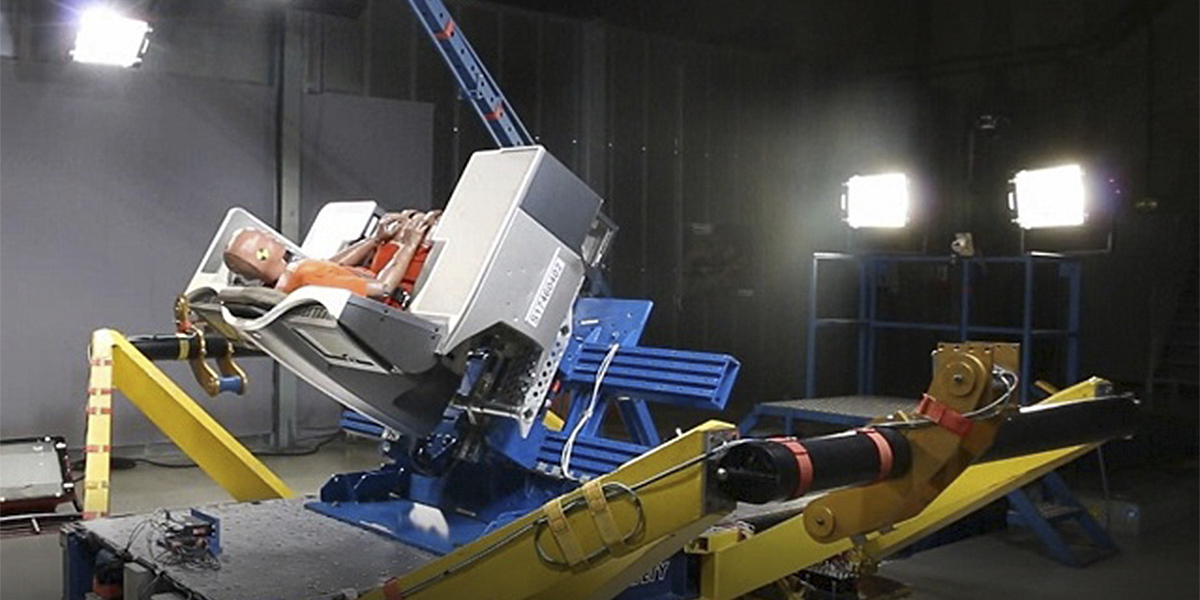ASTM E23 Charpy Impact Test of Airbag Housing Materials
The ASTM E23 standard specifies the procedure for performing the Charpy impact test on materials. This testing method evaluates the notched impact toughness of various materials by measuring their resistance to fracture under a controlled impact. In the context of automotive passive safety systems, this test is particularly relevant when assessing the integrity and performance of airbag housing materials.
During an ASTM E23 Charpy impact test, a sample is mounted in a pendulum impact testing machine, where it receives a sharp, notched cut along its length. The device then swings down to strike the material sample with high velocity. The force required to break through the specimen measures its toughness and ductility. This data helps manufacturers ensure that airbag housings can withstand the extreme forces encountered during deployment without compromising safety.
For automotive applications, materials like polyurethane foams or specific types of polymers are subjected to this test. These materials must meet stringent requirements for durability under real-world conditions. The Charpy impact testing is crucial in validating that airbag housings can function correctly even after being exposed to high-impact environments.
The ASTM E23 standard ensures consistency and comparability across different laboratories and industries, making it a reliable method for quality control and compliance purposes. By adhering strictly to this protocol, manufacturers can produce airbags with consistent performance characteristics, which is essential for automotive safety.
Understanding the importance of this test requires recognizing its role in ensuring that materials used in passive safety systems are robust enough to protect occupants during a crash scenario. The Charpy impact test provides critical insights into how these materials will behave under dynamic conditions, thereby enhancing overall vehicle safety standards.
- Customer Impact and Satisfaction: By leveraging the ASTM E23 Charpy impact test, customers can ensure that their airbag housings meet rigorous international standards. This testing method helps in achieving high-quality products that comply with global automotive safety regulations, leading to enhanced customer satisfaction through reliable performance.
In summary, the ASTM E23 Charpy impact test plays a pivotal role in quality assurance for airbag housing materials within the automotive industry. It ensures that manufacturers produce safe and effective components by evaluating their resistance to fracture under controlled conditions. This contributes significantly to enhancing vehicle safety standards globally.
Scope and Methodology
The ASTM E23 Charpy impact test is applicable to a wide range of materials used in various industries, including automotive manufacturing. Within the context of passive safety systems testing, this method evaluates the notched impact toughness of airbag housing materials by measuring their resistance to fracture under defined conditions.
The scope of the ASTM E23 standard includes the preparation and mounting of samples for testing as well as the application of controlled impacts using a pendulum-type machine. The test involves striking the sample with specified energy levels while recording any resulting fractures or breaks. Acceptance criteria are based on the location, type, and extent of fracture observed.
The methodology outlined in ASTM E23 provides clear instructions for conducting the test accurately and consistently across different facilities. It includes details on specimen preparation, mounting procedures, pendulum settings, and data analysis techniques. Compliance with these guidelines ensures reliable results that can be used confidently by engineers and quality assurance personnel involved in product development and certification processes.
For automotive applications specifically, this testing method focuses primarily on materials such as polyurethane foams or specialized polymers designed for airbag housings. These materials must demonstrate sufficient toughness to withstand the high forces generated during an airbag deployment event without failure. By adhering strictly to ASTM E23 standards, manufacturers can ensure that their products meet strict safety requirements set forth by regulatory bodies around the world.
The consistent application of this testing method across various laboratories guarantees uniformity in results and promotes trust among stakeholders involved in automotive manufacturing. This reliability is crucial for maintaining high-quality product standards while ensuring compliance with international regulations governing passive safety systems.
Eurolab Advantages
At Eurolab, we understand the critical importance of accurate and consistent testing when it comes to evaluating airbag housing materials. Our state-of-the-art facilities equipped with advanced equipment allow us to perform ASTM E23 Charpy impact tests reliably and efficiently. Here are some key advantages that set Eurolab apart:
- Accurate Results: Using precision instruments calibrated according to international standards, we ensure precise measurements of material properties.
- Comprehensive Analysis: Our experienced technicians provide detailed reports on test results, offering insights into the performance characteristics of your materials.
- Consistent Compliance: By following ASTM E23 rigorously, we guarantee that all tests meet required specifications and regulatory standards.
- Expertise in Automotive Testing: Our team has extensive experience working with automotive components, ensuring that our services align perfectly with industry needs.
- Efficient Turnaround Time: We prioritize timely delivery of reports to keep your projects on schedule.
- Cost-Effective Solutions: With competitive pricing and comprehensive service offerings, Eurolab provides excellent value for money without compromising quality.
By choosing Eurolab for your ASTM E23 Charpy impact testing needs, you can rest assured that your airbag housing materials will undergo thorough evaluation under controlled conditions. This ensures not only compliance with international standards but also enhances the overall safety and reliability of automotive systems.





